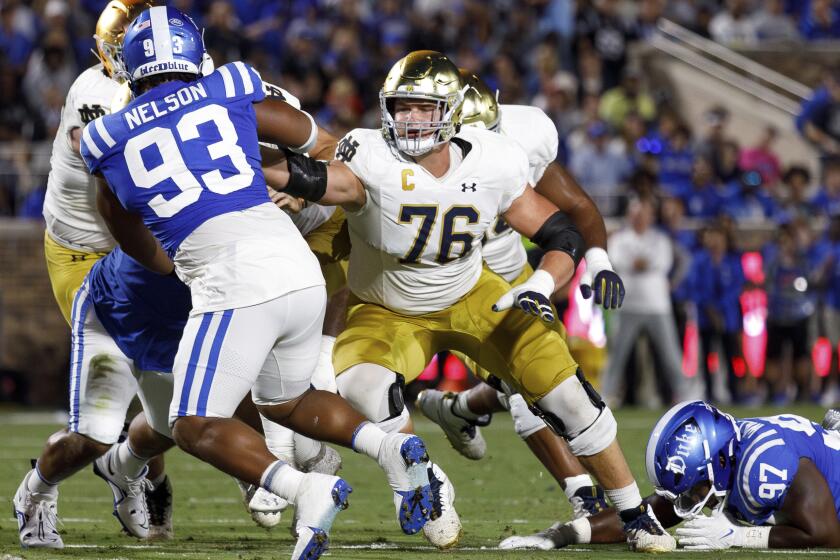These baseball players are making themselves right at home
A man’s homeland is wherever he prospers.
— Aristophanes
Three things fans can count on this season at Angel Stadium: fireworks after Angels homers, the Rally Monkey appearing in late innings when the home team needs a run and Scott Downs shutting down the opposition.
It’s “Inning Over” whenever the Angels left-hander emerges from the bullpen behind left field. He has not given up a run in 20 2/3 innings, striking out 17 and walking only two to go with his immaculate 0.00 earned-run average.
Away from Angel Stadium, Downs doesn’t have the same halo of invincibility. The reliever has a solid but unspectacular 2.66 ERA in 20 2/3 innings, striking out nine and walking seven.
Welcome to Splitsville, where one’s success at home rarely correlates to his performance in the other 29 ballparks. Downs is hardly the only example of this disparity in home and away statistics.
Generally, players tend to perform better at home. Major league hitters were batting .259 at home through Wednesday, as opposed to .251 on the road. Pitchers had a 3.80 ERA at home, compared to a 4.04 ERA on the road.
Not that there aren’t more than a handful of exceptions. Angels infielder Maicer Izturis is hitting .317 on the road versus .227 at home, and Angels left fielder Vernon Wells has hit 12 of his 17 homers away from Angel Stadium.
“Sometimes it’s hard to explain because for me, it doesn’t matter if I play here or on the road,” Izturis said. “I just prepare myself to play baseball.”
Players said getting ready for a game is easier at home, where familiarity with one’s surroundings and routines helps them focus and fans boost their adrenaline.
Home teams are also afforded little luxuries that add up, such as preferential bullpen locations protected from fans and indoor batting cages adjacent to their clubhouses. Visiting players must take batting practice last, giving their home counterparts an extra 40 minutes or so to relax before each game.
“You’re at home, you’re sleeping in your own bed, the fans are with you and not against you and everything’s kind of in your favor,” said Angels right fielder Torii Hunter, whose .286 average at home is 54 points higher than on the road. “That’s why they call it home-field advantage.”
Try telling that to Texas Rangers pitchers. They have a 4.47 ERA this season at the hitter’s haven that is the Ballpark in Arlington, where the Angels open a three-game series Friday. The same Texas pitching staff that has yielded 77 homers at home has given up only 57 homers on the road, where it has compiled a 3.19 ERA.
It’s pretty much the same story at Coors Field, where Colorado Rockies pitchers have surrendered 78 homers as opposed to 60 on the road.
Baseball is the only major team sport in which players’ success can be influenced by the design of each stadium, with different outfield dimensions, mounds and hitter’s backdrops. Baltimore center fielder Adam Jones has hit 18 of his 22 homers this season at Camden Yards.
“That’s cool,” said Jones, who was unaware of his power surge at home. “I need to clean it up on the road.”
Dodgers ace Clayton Kershaw has been good on the road, going 7-4 with a 3.17 ERA. But he has been phenomenal at Dodger Stadium, where he is 9-1 with a 1.88 ERA.
“Dodger Stadium is a great place to pitch … you have to take that into consideration,” said Kershaw, who also noted that the ball doesn’t travel as well at night there as it does during the day.
Not surprisingly, then, Dodgers hitters have fared better on the road than at home, batting .240 with 35 homers at Dodger Stadium as opposed to .266 with 57 homers elsewhere.
Although Angel Stadium is considered more of a neutral ballpark that doesn’t favor pitchers or hitters, Angels ace Jered Weaver has turned it into a house of horrors for opposing batters. He is 7-1 with a 1.38 ERA at home versus 8-5 with a 2.60 on the road.
“I think any pitcher will tell you they’re more comfortable pitching at home than they are on the road,” Weaver said. “But some road stadiums you’re more comfortable in than others.”
In 2007, Ervin Santana couldn’t seem to find a stadium outside of Anaheim that suited him. The Angels right-hander went 1-10 with an 8.38 ERA on the road that year. But in three of the four seasons since, his ERA has been lower on the road than it has been at home.
“I think you just have different years and different splits,” said Wells, who typically hit more homers at home in each of his first nine full seasons with Toronto before being traded to the Angels in January. “On the road there’s probably some more homer-friendly ballparks than we play in here.
“But next year it could be completely different and I could hit more here.”
That would surely please Angels fans who have booed Wells throughout a season in which his averages at home (.209) and on the road (.208) are equally abysmal but he has tallied 28 of his 46 RBIs away from Anaheim. The pressure to perform, particularly for a player in his first season with a team, can be a struggle in front of a home crowd, said Patrick Cohn, an Orlando-based sports psychology expert.
“There’s a likelihood they’re going to try too hard or worry about what others think and feel pressure to do to do well and that could work against them,” Cohn said. “It depends on your individual framework and character, but I would say by and large most professionals are going to get that home-field advantage and feed off the energy of the crowd.”
That seems to be the case for Downs, the reliever who has made a habit of excelling at home. The 35-year-old journeyman who has played for four teams in 10 years is 21-11 with a 2.88 ERA over his career at home versus 12-19 with a 4.45 ERA on the road.
This year, he has been nothing short of divine at Angel Stadium.
“It’s fun because the crowd gets into it,” Downs said. “There’s 39,000, 40,000 people in the stands, so the adrenaline kind of kicks in as well. It’s a comfort zone that you have, being at home.”
Times staff writer Jim Peltz contributed to this report.
More to Read
Get our high school sports newsletter
Prep Rally is devoted to the SoCal high school sports experience, bringing you scores, stories and a behind-the-scenes look at what makes prep sports so popular.
You may occasionally receive promotional content from the Los Angeles Times.







